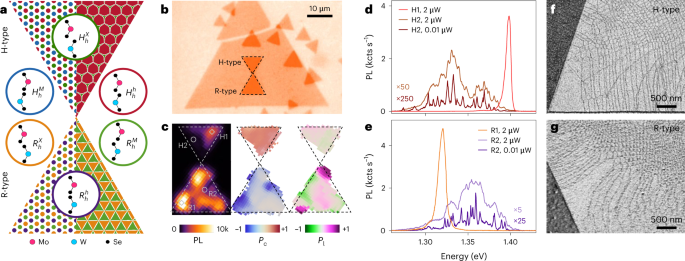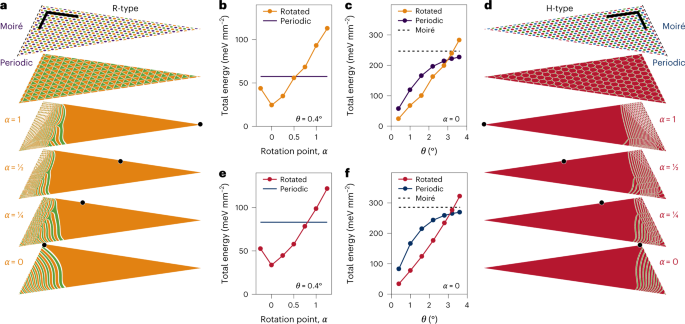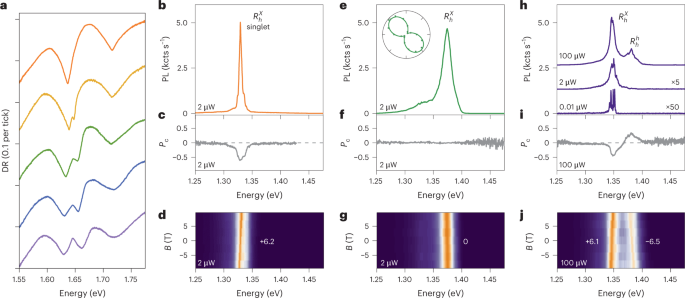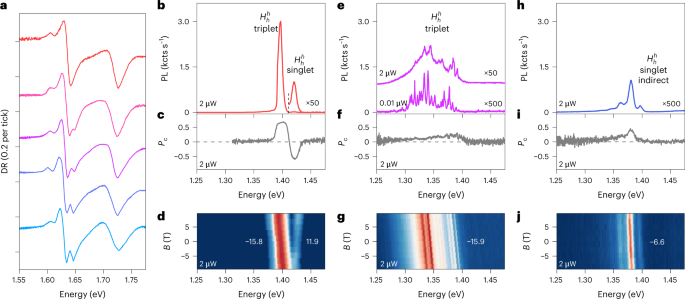Vertical assemblies of twisted or lattice-mismatched heterobilayers of two-dimensionaltransition metal dichalcogenides (TMDs) with moiré-modulated interlayer coupling give rise to correlated Hubbard-model physics1—exhibiting signatures of collective phases in both transport2,3,4,5 and optical experiments6,7,8,9. Periodic moiré interference patterns have profound effects on the electronic band structure due to formation of flat mini-bands that enhance many-body correlations, and induce emergent magnetism6, correlated insulating states2,3,4,7,8,9 or Wigner crystals7. Moiré effects also result in rich optical signatures of intralayer10 and interlayer11,12,13,14 excitons that are formed by Coulomb attractions among layer-locked and -separated electrons and holes, with angle-controlled exciton valley coherence and dynamics15,16, optical nonlinearities17 or correlated excitonic insulating states18.
Despite the extensive optical studies of moiré effects in TMD heterobilayers such as MoSe2–WSe2 (ref. 19), a consolidated picture of the rich experimental features remains elusive20. The experimental results for the peak energies of the interlayer exciton photoluminescence (PL)21,22, g-factor11,22 and degree of polarization11,12 are inconsistent, and the PL spectra can differ substantially from spot to spot even in the same sample23. The diversity of models invoked to explain the plethora of experimental signatures is not inherent to the theory of moiré excitons24,25,26 but is instead related to variations in actual samples. For TMD bilayers with small twist angles, in particular, canonical moiré superlattices are known to transform into periodic domains of distinct atomic registries in triangular or hexagonal tiling27,28,29,30,31,32,33, as dictated by the competition between the intralayer strain and interlayer adhesion energies34,35,36. Correlative studies of reconstruction and exciton features are so far limited to twisted homobilayers28,29, providing only indirect insight into exciton landscapes of mesoscopically reconstructed moiré heterostructures.
Canonical and periodically reconstructed moiré heterostructures
Ideal moiré heterostructures emerge in vertical heterobilayer (HBL) assemblies of distinct TMD monolayers without an inversion centre, and distinguish between parallel and antiparallel alignments near 0° and 180° twist angles of R- and H-stackings. Due to the lattice mismatch of the monolayer constituents, both the R- and H-type heterostacks form moiré patterns with superlattice constants of ~100 nm in aligned MoSe2–WSe2 HBLs, which reduces asymptotically to the monolayer lattice constant with increasing twist away from the high-symmetry configurations. Following lateral translation through a moiré supercell, each stacking modulates through points of highly symmetric atomic registries (({H}_{h}^{h}), ({H}_{h}^{M}), ({H}_{h}^{X}) and ({R}_{h}^{h}), ({R}_{h}^{M}), ({R}_{h}^{X})), which are shown schematically in the coloured circles of Fig. 1a for a heterostack of top MoSe2 and bottom WSe2 monolayers.
a, Schematics of H- and R-type heterostacks with ideal moiré (left) and periodically reconstructed (right) patterns. The coloured regions represent high-symmetry atomic registries, as illustrated in the respective circles. b, Optical micrograph of sample 1 with H- and R-stacks (delimited by dashed lines) of CVD-grown MoSe2 monolayers (small triangles) on a large WSe2 monolayer (large triangle). c, Interlayer exciton PL map (left) with selected bright (H1, R1) and dark (H2, R2) spots indicated by diamonds and circles, respectively, as well as Pc (middle) and Pl (right) maps for the H and R-stacks in b. d,e, Photoluminescence spectra at the bright and dark spots marked in c. At an excitation power of 2 μW, the H1 and R1 spectra are representative for regions with a single bright peak, whereas the H2 and R2 spectra (scaled by 50 and 5, respectively) are characteristics of dark regions with broad and structured PL, which evolves into narrow peaks at a low excitation power of 0.01 μW (scaled by 250 and 25, respectively). All spectroscopy data were recorded on sample 1. f,g, Scanning electron micrographs of H- (f) and R- (g) heterostacks recorded with secondary electron imaging.
For rigid lattices, the resulting moiré pattern is shown on the left side of the H (top) and R (bottom) triangles (Fig. 1a). The positions of high-symmetry registries with identical areas are represented by their respective colours, spanning a periodic lattice of laterally alternating registries with gradual interconversion according to the geometrical interference condition. In the presence of local lattice deformation, however, the ideal moiré pattern transforms into periodically reconstructed patterns, which are shown on the right side of the triangles. Driven by competition between intralayer strain and interlayer adhesion energy, energetically favoured registries expand at the expense of unfavourable ones into periodic domains with areas inversely proportional to the squared twist angle θ2. Theoretical and experimental results27,34 indicate for H-type heterostacks that only ({H}_{h}^{h}) stacking prevails in hexagonal domains after reconstruction, whereas in R-type heterostacks, ({R}_{h}^{X}) and ({R}_{h}^{M}) consolidate into tessellated triangular domains as two equally optimal registries.
The ideal and reconstructed moiré landscape scenarios of Fig. 1a can in principle be discerned by optical spectroscopy, despite the length-scale mismatch between the optical spot size (on the order of a micrometre) and the domain size (dimensions well below 100 nm). By using the distinct PL characteristics of interlayer excitons in atomic registries of MoSe2–WSe2 HBLs listed in Table 1, the observer could infer the contribution from each domain present in the optical spot. By virtue of unique spin-valley configurations, stacking symmetries and related degrees of interlayer coupling, R- and H-type interlayer excitons exhibit distinct transition energies25,26,36,37,38, oscillator strengths37,38 and dipolar selection rules25,26,39 that are accessible via optical spectroscopy. Moreover, magneto-luminescence experiments allow the assignment of interlayer exciton PL to the domains of specific registries using first-principles calculations of exciton Landé g-factors38,40,41 and experimental values. This conceptual clarity, however, is contrasted by the puzzling diversity of moiré exciton signatures in MoSe2–WSe2 HBLs.
Mesoscopic reconstruction in experiment and theory
In this work we fabricated HBL samples from MoSe2 and WSe2 monolayers exfoliated from native crystals or synthesized by chemical vapour deposition (CVD) (see the Methods for details). For the sample in Fig. 1b based on CVD-grown monolayers, we placed single-crystal MoSe2 triangles on top of a large WSe2 triangular monolayer by standard dry-transfer. The resulting HBL triangles with small-twist-angle H- and R-stackings are delimited by dashed lines in the optical micrograph of Fig. 1b. All of the HBLs were encapsulated in hexagonal boron nitride (hBN) to access narrow exciton linewidths in cryogenic spectroscopy42.
Figure 1c shows the PL characteristics in the spectral bandwidth of interlayer excitons. The laterally extended maps recorded at 3.2 K show the integrated PL intensity and the degrees of its circular (Pc) and linear (Pl) polarizations43. The PL map exhibits sizable intensity variations across both stacks, with much brighter emission in the R-stack. These variations are accompanied by changes in the spectral characteristics, shown representatively in Fig. 1d,e. In the upper-right and lower-left bright corners of the H- and R-type triangles (H1 and R1, respectively), the corresponding PL spectra feature only one peak at 1.40 and 1.33 eV, with the highest degrees of circular polarization and opposite signs in the Pc map of Fig. 1c. These signatures jointly suggest that both stacks feature areas on the scale of the optical spot that are entirely dominated by the respective triplet and singlet interlayer excitons of the ({H}_{h}^{h}) and ({R}_{h}^{X}) registries. Given the finite twist angle in our sample, the absence of PL contributions from all other registries is striking.
The signatures of bright spots are contrasted on positions with low PL (labels H2 and R2), and are shown as brown and purple spectra in Fig. 1d,e. At the expense of single-peak spectra, the PL is structured and spectrally dispersed over 100 meV on the low- and high-energy sides of the solitary peaks of the triplet ({H}_{h}^{h}) and singlet ({R}_{h}^{X}) interlayer excitons, respectively. On dark spots and under identical excitation conditions, the integrated PL is typically much lower (note the scaling by 50 and 5 for H- and R-type spectra, respectively), and Pc is reduced in its absolute value, although preserved in sign. These features of moiré effects12,23,38 evolve into a series of spectrally narrow peaks at reduced excitation powers, signifying interlayer exciton localization in moiré quantum dots11,23.
In addition to the co-existence of contrasting features in one sample, confusion arises from the observation of a finite degree of linear polarization with variations across the Pl map of Fig. 1c. According to Table 1, the dipolar selection rules of interlayer excitons dictate valley contrasting circularly polarized out-of-plane and in-pane z-polarized transitions25,26,39. Whereas the former constitute positive and negative Pc in the maps of the H- and R-type stacking (Fig. 1c), the latter should exhibit neither circular nor linear degrees of polarization when probed in back-scattering configuration38. By contrast, the map in Fig. 1c exhibits regions with high Pl (note the upper- and lower-left corners of the R-type triangle), reminiscent of quantum wire effects as in uniaxially strained moiré landscapes44 or HBL samples with transfer-induced layer corrugation45.
All of the above features manifest consistently across the samples of our studies (see Supplementary Notes 1 and 3 for other samples). The key to the understanding of such variations in the optical features on one sample is provided by mesoscopic reconstruction, which we visualize with secondary electron imaging in scanning electron microscopy (SEM)29. The images of H- and R-heterostacks near the triangle edges with stacking-sensitive contrast (Fig. 1f,g and Supplementary Note 1) provide evidence for the formation of large domains of one atomic registry separated by thin lines of domain walls. The domain networks observed in different samples exhibit common patterns on the mesoscopic scale: extended 2D domains at HBL tips and edges are surrounded by elongated 1D stripes that merge in the sample core into a network of finely structured domains with dimensions well below 100 nm, forming quasi 0D arrays.
Mesoscopic reconstruction is driven by the interplay of intralayer strain and interlayer adhesion energy. Recent theoretical work34,35,36 pointed out that moiré lattices of marginally twisted bilayers relax on the nanoscale into periodic domains by rearranging lattice atoms according to a vectorial 2D displacement field that overcompensates for the associated strain cost with the gain in interlayer adhesion. To provide intuition for domain formation on scales from a few to a few hundred nanometres, we adopt the theoretical model of lattice reconstruction35 and account for finite size effects and singular point rotations that can grow to large-area 2D domains of optimal stacking. In brief, we model the tip of a HBL with small twist angles by using an equilateral triangle, with its micrometre-sized base connecting to the rest of the triangle with ideal moiré periodicity (see Supplementary Note 2 for details). On the line bisecting the triangular tip into two equal halves, we place a point of zero-twist deformation to create an initial lattice-displacement field, which is modified in consecutive iterations to obtain a stacking configuration from the final displacement field, minimizing the sum of the intralayer strain and interlayer adhesion energies in the tip area. This procedure yields a series of reconstructed landscapes, characterized by their respective initial displacement fields.
The results of our numerical simulations are shown for R- and H-type HBLs with a twist of θ = 0.4° (Fig. 2a,d). The top two maps illustrate the ideal moiré and periodically reconstructed patterns, whereas the four maps below show reconstruction patterns after optimization of initial displacement fields that untwist the HBL around a rotation centre indicated by black points and labelled by a dimensionless coordinate α = 1, 0.5, 0.25, 0. In all cases, optimization yields mesoscopic reconstruction into 2D domains of energetically favoured stackings at the triangle tip (({R}_{h}^{X}) or ({R}_{h}^{M}) and ({H}_{h}^{h}) in R- and H-stacks). These extended domains are flanked by 1D stripes, which merge into 0D domain arrays.
a,d, Maps of reconstructed domains in triangular tips of R-type (a) and H-type (d) heterostacks with a twist angle θ = 0.4° (only triangle halves are shown in the projections; the scale bars are 200 nm). The top maps show moiré patterns without reconstruction (delimited by dashed lines from the moiré core of the HBL), whereas the maps below show periodic reconstruction and mesoscopically reconstructed domain patterns obtained for different zero-twist deformations around the points marked by black dots at dimensionless positions α (note that the orange ({R}_{h}^{X}) and green ({R}_{h}^{M}) domains can interconvert due to similar adhesion energies35). b,e, Total areal energy for R (b) and H (e) at θ = 0.4°, and different untwisting points α (the energy of the respective periodic patterns is shown by solid lines). c,f, Total areal energy of periodic and optimally reconstructed (for α = 0) patterns for different twist angles θ in R (c) and H (f) (the energy of the respective moiré patterns is indicated by the dashed lines).
As expected, optimality reconstructed patterns minimize the total energy of the system according to our simulations shown for R-type (Fig. 2b,c) and H-type (Fig. 2e,f) HBLs. For θ = 0.4°, the total energy (normalized by the triangle area) in both stackings is reduced by a factor of 10 and 2 below the energies of ideal moiré and periodic limits, respectively (solid lines in Fig. 2b,e), on reconstruction after optimal rotation at α = 0. The global energy minimum—obtained for the rotation point at the borderline between the moiré core and the triangle base—features the most direct transition from the 2D domain through 1D stripes to the 0D core. As the rotation point is moved towards the tip (via 0 < α < 1), 0D regions emerge at the border and the energy gain decreases, passing the threshold of periodic reconstruction at α ≃ 0.5 (0.75) in the R (H) heterostack but remaining well below the moiré lattice energy throughout. Remarkably, for the optimally relaxed tip around α = 0, mesoscopic reconstruction remains energetically favourable for twist angles up to θ = 3° for both stackings (Fig. 2c,f), in accordance with conclusions from recent Raman spectroscopy studies46.
Excitons in reconstructed R-heterostacks
With the intuition for mesoscopic reconstruction, we revisit distinct spectroscopic features of R-stacks in the intralayer and interlayer exciton spectral range with differential reflection and PL, respectively. The differential reflection spectra—proportional to intralayer exciton absorption—evolve as the observation spot is moved from bright to dark PL areas (Fig. 3a). Following displacement, the differential reflection resonances around the MoSe2 and WSe2 intralayer exciton transitions at 1.64 and 1.71 eV on the bright spots (top spectrum) gradually develop split resonances and broadening that is most pronounced in the darkest areas (bottom spectrum). This evolution reflects the presence of only one registry in bright spots, and modulation of the intralayer exciton energy by alternating stackings in the darkest spots. As resonant hybridization in MoSe2–WSe2 heterostacks is strongly inhibited by large band offsets, multi-peak differential reflection spectra result from different intralayer exciton energies within the different registries probed by the optical spot.
a, Evolution of differential reflection (DR) spectra of intralayer excitons following gradual displacement from a bright to dark region (shown from top to bottom for positions indicated by the black dots in Supplementary Fig. 9a). The peak multiplicity is a hallmark of nanoscale reconstructed domains. b–d, Interlayer exciton PL (b), Pc (c) and dispersion in a perpendicular magnetic field B (d), characteristic of extended 2D domains. The magneto-luminescence data were recorded under linearly polarized excitation with σ+ detection to determine the g-factor values from linear slopes. e–g, Same as b–d but for regions of 1D stripes with a large degree of linear polarization (as shown in the inset). h–j, Same as b–d but in a dark sample region of 0D domains (PL spectra shown with offsets and different scaling for excitation powers of 100, 2 and 0.01 μW). All data were recorded on sample 2 (Supplementary Fig. 9) ; g-factor values with least-square error bars were obtained from linear fits to the data shown in Supplementary Fig. 16.
Bearing in mind the absence of peak multiplicity in the differential reflection spectra of bright spots, the corresponding characteristics of interlayer exciton PL (Fig. 3b–d) are readily explained. Due to locally extended reconstruction, only lowest-energy ({R}_{h}^{X}) singlet excitons contribute to PL (Fig. 3b), with a peak at 1.33 eV and full-width at half-maximum linewidth of 6 meV, a negative Pc (Fig. 3c) and a positive g-factor of ~6 (Fig. 3d), as in aligned HBLs21. Such characteristics are frequently observed at sample edges and tips (as in Fig. 1c) where large-scale reconstruction is energetically most favourable (as in the reconstructed maps of Fig. 2a).
The PL from spatially neighbouring regions is indicative of quantum wire domains44, with blue-shifted emission at around 1.36 eV, a high Pl (inset in Fig. 3e), and a vanishing Pc and g-factor value (Fig. 3f,g). In R-stacks, quantum wires are formed by alternating optically bright ({R}_{h}^{X}) and dark ({R}_{h}^{M}) domains. The related 1D confinement of interlayer excitons in stripes of lower-energy ({R}_{h}^{X}) domains flanked by potential walls of higher-energy ({R}_{h}^{M}) states not only breaks the threefold rotational symmetry of the exciton wave function (thereby admixing K and ({K}^{{prime} }) valleys, and obliterating both Pc and g-factors in perpendicular magnetic field), it is also responsible for the blue-shift in PL energy. Spot-to-spot variations between sample regions of high Pl, with varying orientations of linear polarization axes, are consistent with the diversity of stripe geometries. A prominent example is the left corner of the R-type triangle in Fig. 1c, in which the bright spot of a large ({R}_{h}^{X}) domain with Pc ≃ −1 is encompassed by quantum wire regions with Pl ≃ ±1.
Quantum confinement is also prominent in R-type regions of 0D arrays that have much reduced PL intensity and spectrally narrow lines at low excitation powers (note the scaling by 5 and 50 for the spectra at 2 and 0.01 μW, respectively, in Fig. 3h), with characteristic negative Pc (Fig. 3i) and g-factors of around ±6 (Supplementary Figure 14b)11. Depending on the actual spot, such quantum dot lines with a full-width at half-maximum well below 1 meV can be observed within spectrally narrow or broad windows of 10 or 100 meV (as seen in Fig. 3h and Fig. 1e, respectively) above the peak of extended ({R}_{h}^{X}) domains at 1.33 eV. Obviously, regions of 0D arrays increase the energy of interlayer excitons by quantum confinement in nanoscale domains of ({R}_{h}^{X}) stacking, with potential barriers formed by adjacent ({R}_{h}^{M}) domains, whereas the variations in PL energies relate to different strengths of confinement in quantum boxes of varying size.
The spectrally dispersed PL from inhomogenously reconstructed arrays merges at elevated excitation powers (spectra at 2 μW in Figs. 3h and 1e) into structured PL peaks of sub-ensembles grouped by similar length scales. Reconstructed 0D arrays with lateral homogeneity give rise to a narrow ensemble of emission energies (within 10 meV as in Fig. 3h), which allows us to observe hot luminescence with a positive Pc and negative g-factor of −6.5 (Fig. 3i,j at 100 μW excitation power). These features—absent in the spectra of 1D and 2D domains—correspond to ({R}_{h}^{h}) singlet interlayer excitons ~50 meV above ({R}_{h}^{X}) states. Such a prominent contribution of ({R}_{h}^{h}) stacking to the PL is surprising, as theory predicts vanishingly small areas for this non-optimal stacking34,35,36. The sizable PL with ({R}_{h}^{h}) characteristics therefore either implies areas of ({R}_{h}^{h}) domains that are larger than anticipated from theory, or that their exciton population is favoured by population-feeding pathways from excited states or nearby ({R}_{h}^{X}) domains.
Excitons in reconstructed H-type heterostacks
Despite similarities, some aspects of mesoscopic reconstruction in H-type HBLs are distinct. The differential reflection spectra of intralayer excitons in the bright and dark PL regions shown in Fig. 4a (the feature at 1.61 eV is due to residual doping in this sample) lead to the same conclusion as for the R-type spectra of Fig. 3a, that is, multi-peak intralayer differential reflection resonances in regions of dark PL are absent in the regions of bright PL. For the latter, the atomic registry of reconstructed 2D domains is ({H}_{h}^{h})—unrivalled by other registries in terms of energy-optimizing stacking31,34,35. The respective PL spectrum of interlayer excitons (Fig. 4b) is therefore simple, featuring only the emission peaks of triplet and singlet configurations at 1.40 and 1.42 eV with positive and negative Pc (Fig. 4c), and g-factors of −15.8 and 11.9 (Fig. 4d), respectively21,47,48.
a, Evolution of differential reflection spectra of intralayer excitons following displacement from a bright to dark region (shown from top to bottom curves for positions indicated by red dots in Supplementary Fig. 10a) with peak multiplicity stemming from reconstructed nanoscale domains. b–j, Interlayer exciton PL (b, e, h), Pc (c, f, i) and B-field dispersion (d, g, j) for three representative positions. The magneto-luminescence data were recorded under linearly polarized excitation with σ+ detection to determine the g-factor values from linear slopes. Spots with bright PL (as in b) feature triplet and singlet peaks with opposite Pc signs and characteristic g-factors of about −16 and 12. Sample positions with low PL intensity exhibit structured spectra (as in e and h) with reduced Pc. Their characteristics differ both in spectral profiles and g-factors. Data in e–g are from sample 2, whereas all other data are from sample 3 (see Supplementary Fig. 10). The g-factor values with least-square error bars were obtained from linear fits to the data in Supplementary Fig. 17.
As for R-type HBLs, the differential reflection spectra exhibit an increasingly pronounced splitting of the MoSe2 intralayer exciton resonance in dark regions of H-type samples (bottom spectra in Fig. 4a). In the respective PL spectra (Fig. 4e), for low and moderate excitation powers (0.01 and 2 μW, respectively) we again observe spectrally sharp peaks developing into a multi-peak ensemble of 0D arrays with an inhomogeneous size distribution of nanoscale domains in optimal ({H}_{h}^{h}) stacking. The positive Pc (Fig. 4f) and the g-factor values (Fig. 4g) confirm ({H}_{h}^{h}) stacking as the origin of the emission.
For this stacking, theoretical estimates (Table 1) place its optically bright interlayer exciton states at the top of the energy hierarchy above the dark ({H}_{h}^{M})and ({H}_{h}^{X})states. This energetic ordering is responsible for the absence of 1D features found in R-stacks: excitons in reconstructed ({H}_{h}^{h}) domains are not bound by potential barriers that would mix K and ({K}^{{prime} }) states as in 1D quantum wires of R-stacks (note the absence of areas with high Pl throughout the map of H-type triangle in Fig. 1c). Our theory predicts that reconstructed ({H}_{h}^{h}) domains preserve luminescent exciton population on spatially extended plateaus, whereas the PL intensity decreases in regions of 0D arrays (note the scaling factors of 50 and 500 in Fig. 4e) due to population drain into lower-energy states of the surrounding ({H}_{h}^{M})and ({H}_{h}^{X})domains with much reduced optical activity and domain areas. Consistently, nanoscale domain formation is accompanied by PL red-shifts of up to 100 meV below the ({H}_{h}^{h}) triplet peak at 1.4 eV.
For completeness, in Fig. 4h–j we show the PL characteristics of a dark area in an H-stack with about 3° twist. The heterostack is not entirely prone to reconstruction, with tips and edges exhibiting signatures of bright ({H}_{h}^{h}) domains (see Supplementary Fig. 10); however, the dark areas of the sample exhibit very different features than reconstructed 0D arrays discussed above, implying that the HBL largely maintains its canonical moiré structure. As shown in Fig. 4h, the PL at 2 μW excitation power is reduced by another factor of 10 (note the scaling factor of 500), with a positive Pc (Fig. 4i) and a negative g-factor of −6.6 (Fig. 4j) that has no counterpart in the realm of zero-momentum ({K}^{{prime} }K) interlayer excitons of H-type registries yet is characteristic of finite-momentum KK exciton states (see Supplementary Table 2). The peaks with equidistant energy spacing of 16 meV up to the sixth order (Supplementary Fig. 18) are indicative of interlayer exciton–polaron formation49. In this regime, the heterostructure with layer- and valley-separated excitons dressed by strong exciton–phonon coupling is rendered momentum-dark, with luminescent population decay of exciton–polaron states mediated by a series of phonon replicas.
- SEO Powered Content & PR Distribution. Get Amplified Today.
- Platoblockchain. Web3 Metaverse Intelligence. Knowledge Amplified. Access Here.
- Source: https://www.nature.com/articles/s41565-023-01356-9



